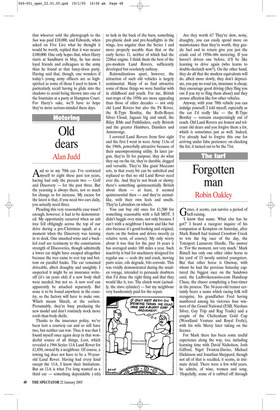Old dears
Alan Judd
And so to my 70th car. I’ve restricted myself to eight these past ten years, having had only the present two — Golf and Discovery — for the past three. But the yearning is always there, not so much for change as for increase. My excuse for the latest is that, if you need two cars daily, you actually need three.
Pleading this very reasonable case wasn’t enough, however; it had to be demonstrated. My opportunity occurred when an ash tree fell obligingly across the top of our drive during a pre-Christmas squall, at a moment when the Discovery was turning in to dock. One smashed wino and a buckled roof are testimony to the construction strength of Discoveries, though admittedly a lower car might have escaped altogether because the tree came to rest top and bottom on parallel banks. The car remained driveable, albeit draughty and unsightly. I suspected it might be an insurance writeoff (it’s six years old) if a new body shell were needed, but not so. A new roof can apparently be attached separately. But none is to be found anywhere in the country, so the factory will have to make one. Which means March, at the earliest. Presumably, they’re busy producing the new model and don’t routinely stock more roofs than body shells.
Thanks to the insurance policy, we’ve been lent a courtesy car and so still have two, but neither can tow. Thus it was that I found myself once again deep in that wonderful source of all things, Loot, which revealed a 1966 Series 11A Land Rover for £1,850, owned by a neighbour. Of course, a towing tug does not have to be a 39-yearold Land Rover. Having had every kind except the 11A, I know their limitations. But an 11A is what I’ve long wanted as a third car — something dependable (-ish) to lurk in the back of the barn, something pre-plastic dash and pre-headlights in the wings, less angular than the Series 1 and more properly useable than that or the early Series 11, neither of which had the 2286cc engine. I think them the best of the pre-modern Land Rovers, sufficiently developed but resolutely unfussy.
Rationalisations apart, however, the attraction of such old vehicles is largely sentimental. Many of us find attractive some of those things we were familiar with in childhood and youth. For me, British rust-traps of the 1950s are more appealing than those of other decades — not only old Land Rovers but also the P4 Rover, the R-Type Bentley, the Rolls-Royce Silver Cloud, Jaguars big and small, the Riley RMs and Pathfinders, early Bristols and the greater Humbers, Daimlers and Armstrongs.
I coveted Land Rovers from first sight and the first I went in were Army 11As of the 1960s, powerfully attractive because of their uncompromising utility. In later jargon, they’re fit for purpose, they do what they say on the tin, they’re durable, dogged and versatile. They’re like giant Meccano sets, in that every bit can be unbolted and replaced so that no old Land Rover need ever die. And they’re not brash or showy; there’s something quintessentially British about them — at least, it seemed quintessential then — and they’re animallike, with their own feels and smells. They’re Labradors on wheels.
You can buy old ones for £1,500 for something reasonable with a full MOT. I didn’t haggle over mine, not only because I can’t with a neighbour I know and like but also because it’s good-looking and original, starts on the button and drives sweetly (a relative term, of course). My only worry about it was that for the past 16 years it has averaged under 100 miles a year. Such inactivity is bad for machinery designed for regular use — seals dry and crack, moving parts seize, oils degrade, bits corrode. This was vividly demonstrated during the maiden voyage, intended to persuade doubters that I’d done the right thing and that they would like it, too. The clutch went (actually, the slave cylinder) — but my neighbour very handsomely paid for the repair. Are they worth it? They’re slow, noisy, draughty, you can easily spend more on maintenance than they’re worth, they guzzle fuel and in return give you just the crude end of 1950s–60s motoring. If you haven’t driven one before, it’ll be like learning to drive again (who learns to double-declutch now?). On the other hand, they do all that the modern equivalents will do, albeit more slowly, they don’t depreciate, you pay no road tax, insurance is cheap, they encourage good driving (they fling you out if you try to fling them about) and they arouse affection like few other vehicles.
Anyway, with your 70th vehicle you can indulge yourself, I told myself, especially as the car I’d really like — the R-Type Bentley — remains exasperatingly out of reach. Old Land Rovers are honest and tolerant old dears and you forgive them a lot, which is sometimes just as well. Indeed, I’ve already had to forgive this one for arriving under false pretences: on checking the list, it turned out to be the 71st.













































 Previous page
Previous page